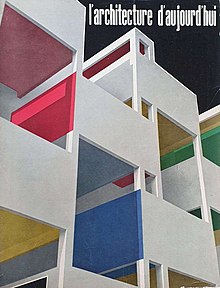L'Architecture d'Aujourd'hui
L'Architecture d'Aujourd'hui ("The Architecture of Today") is a French architecture magazine associated with the Modernist movement.
 Nid d'Abeille of Carrières Centrales in Casablanca on the cover of the December 1954 cover of L'Architecture d'Aujourd'hui. | |
| Categories | Architecture |
|---|---|
| Founder | André Bloc and Marcel Eugène Cahen |
| Year founded | 1930 |
| First issue | October 1, 1930 |
| Country | France |
| Language | French |
History
Beginning
The magazine was founded by André Bloc et Marcel Eugène Cahen in 1930 at the beginning of the recession in Europe.[1] The latter died just before the magazine's first issue released November 1930. Its headquarters were at 5, rue Bartholdi in Boulogne.[2] André Bloc (1896-1966) was trained as an engineer, though he was interested in modernism and architecture.[3][4]
The magazine released 10 issues annually until 1934, when it started to release 12 issues annually.[5] Pierre Vago, a Hungarian, joined in the 1930s and was influential in developing the magazine's network of international correspondents.[5] The magazine offered a variety of subscription types, and achieved rapid success.[5]
In addition to its publications, L'Architecture d'Aujourd'hui organized trips, international meetings, and exhibitions.[5] The first international trip, open to architects and architecture enthusiasts who showed interest, was to the Soviet Union in 1931.[5] The goal of these trips was to see the architecture and establish contacts with architects in the area.[5] During these trips, there were days of discussion to facilitate ideas; they were called Rencontres Internationales des Architects (RIA) and were organized by the magazine's correspondent in each location.[5]
World War II
As André Bloc was Jewish, he could no longer manage the magazine during World War II.[5] André Hermant became editor of the magazine after it was purchased by M. Georges Massé June 1941.[5] Hermant and Massé chose a new name for the magazine: Techniques et Architectures.[5] Upon the liberation of France, Bloc attempted to regain control of the magazine, but was unsuccessful.[5] He had to start from scratch in competition against Techniques et Architectures.[5]
The first issues of Bloc's reborn L'Architecture d'Aujourd'hui came out in 1945.[5] Up until 1949, he released 5 thematic issues annually, one of which was a double issue.[5] The magazine quickly achieved international success again.[5] After the war, Pierre Vago restarted the Rencontres Internationales des Architects.[5] The group was organized as the International Union of Architects in 1948.[5]
References
- Bernfeld, Dan; contemporain (France), Centre interuniversitaire de recherche en histoire de l'art (1994). Un art sans frontières: L’internationalisation des arts en Europe (1900-1950) (in French). Publications de la Sorbonne. ISBN 978-2-85944-254-5.
- Corbusier, Le (December 1999). Le Corbusier Talks with Students. Princeton Architectural Press. ISBN 978-1-56898-196-3.
- Redhead, Steve (2011-06-29). We Have Never Been Postmodern. Edinburgh University Press. ISBN 978-0-7486-8897-5.
- Anastakis, Dimitry (2014-06-22). The Sixties: Passion, Politics, and Style. McGill-Queen's Press - MQUP. ISBN 978-0-7735-7434-2.
- Bernfeld, Dan; contemporain (France), Centre interuniversitaire de recherche en histoire de l'art (1994). Un art sans frontières: L’internationalisation des arts en Europe (1900-1950) (in French). Publications de la Sorbonne. ISBN 978-2-85944-254-5.